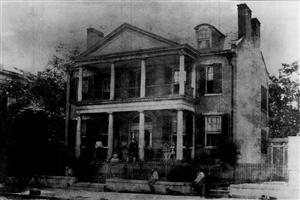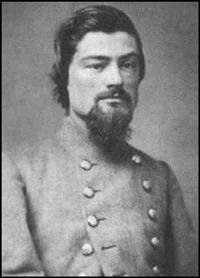The Berthold Mansion
Tour Stop

Directions: The Berthold Mansion [ Waypoint = N38 37.628 W90 11.370 ] was located at the northwest corner of the intersection of Fifth (currently named Broadway) and Pine Streets in St. Louis, Mo. 63102. Currently this location is occupied by One Metropolitan Square, the tallest building in St. Louis.
- It's a short walk of three blocks to this tour stop.
- Walk north on Broadway.
- Stay on Broadway as you cross over Market Street.
- Stay on Broadway as you cross over Chestnut Street.
- Continue walking north on Broadway for one more block until you reach Pine Street

Description: Prior to the election, the Berthold Mansion had been the headquarters for the Democrats in St. Louis, but after the election, it became the headquarters for the pro-southern Minute Men in 1861. During this time it came to be known as Fort Berthold. There was a good deal of excitement in St. Louis, when they raised a large Secession Flag from the roof of the Berthold Mansion on March 4, 1861, the date of Abraham Lincoln's inauguration. Basil Duke, chairman of the Minute Men's Military Committee, described the events taking place that day at the Berthold Mansion: [67]
I called the committee together on the night of the 3d of March, and, after a brief consultation, we decided to display on the succeeding day such unmistakable symbols of secession and evidence of an actively rebellious disposition as would be a plain defiance to the Union sentiment and challenge to the Wide Awakes. We accordingly improvised two secession flags. The South had not then adopted a banner, so we were obliged to exercise our imaginations to a rather painful extent in order to devise a fit emblem. We knew, however, that nothing which floated over the Minute Men's headquarters could be possibly misconstrued, and we blazoned on both flags every conceivable thing that was suggestive of a Southern meaning. Champion and Quinlan undertook to place one of these flags on the very summit of the court-house dome, and did so at great risk to neck and limb. The other was hung out from the front porch of the headquarters. . . Early the next morning, when our ensigns were observed, an extraordinary commotion began in the immediate neighbourhood and soon extended over the entire city. The flag on the court-house was at once removed. We had expected this and could not have prevented it.
Then a large and angry crowd collected in front of the headquarters and demanded the removal of the flag there. When no response was made, some of the boldest climbed up on the porch with threats of tearing it down. They were thrown back on the pavement beneath, but none were seriously injured, although much discouraged. I cautioned my men not to fire unless they themselves were fired on.
The Wide Awakes sprang to arms, but showed no haste to attack. We received notice that they had assembled and formed and were coming. Their drums were loudly in evidence. While unwilling to fire on the mob without the amplest provocation, we were determined to fire on the Wide Awakes so soon as they were in sight; for after the repeated threats they had uttered, their appearance at such a time would have been an unmistakable demonstration of hostility . . .Several abortive rushes were afterward made by the mob, and one or two more serious demonstrations, easily repulsed, however, and with little damage to either faction; and then our friends began to rapidly assemble. After some rough and tumble fighting in the streets it became apparent that our side was the stronger.
